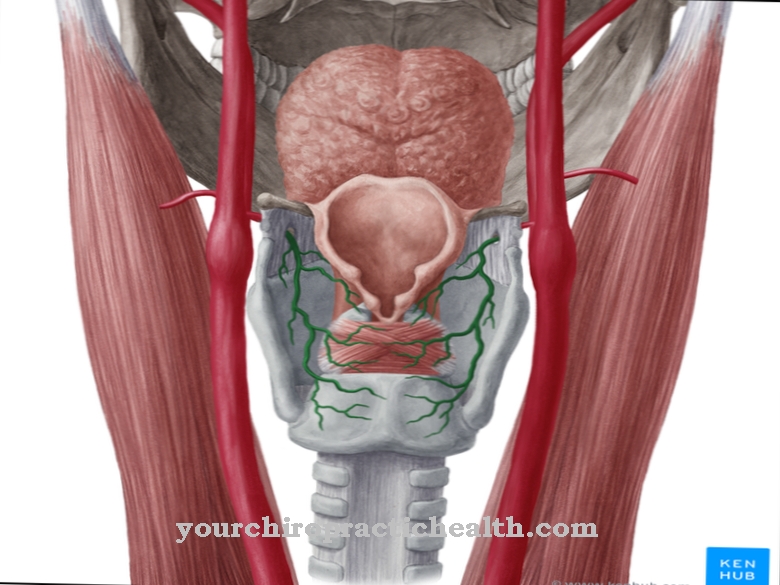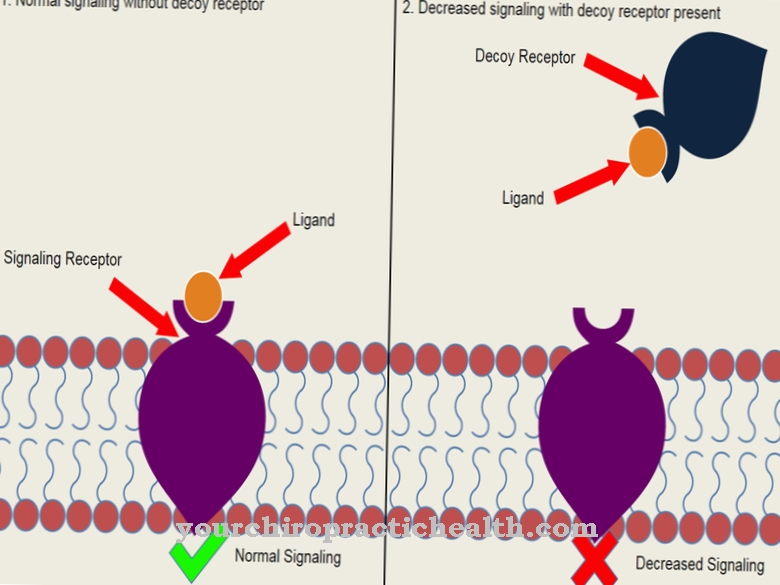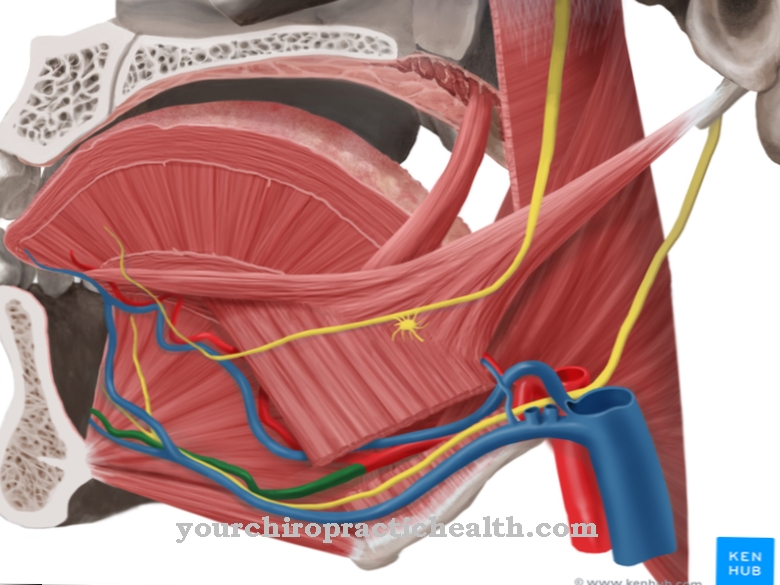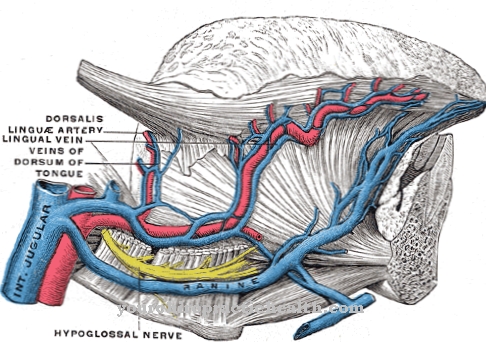The bridge (of the Pons) is a ventrally bulging section of the brain stem. It lies between the midbrain and the medullary brain.
What is the bridge?
The bridge (from the Latin “pons”) is a section in the human brain. Together with the cerebellum, the pons belongs to the hindbrain (metencephalon). Even at a cursory glance at the brain, the bridge is noticeable as a clearly raised transverse bulge. It is located between the midbrain (mesencephalon) and the medullary brain (myelencephalon) and together with both forms the brain stem of the brain in the central nervous system.
Anatomy & structure
The bridge is divided into a front part - the base (lat .: pars basilaris pontis) - and a rear part - the bridge hood (lat .: pars dorsalis pontis).
There are two longitudinal bulges at the base. The so-called pyramidal path (main part of the system of movement control, tractus pyramidalis) runs through both. The basilar artery, which is an important inflow for supplying the brain with blood, runs in the groove in the middle (Latin: basilar sulcus). In the cross-section of the brain there is a clearly visible connecting line between the two halves (raphe), which is crossed by a large number of nerve fibers. The trapezoidal body (Latin: corpus trapezoideum) is located behind the transverse fibers of the pontine base. It forms a station of the auditory pathway (central nervous part of the auditory system).
Dorsally, cranial nerves VII (facial nerve, facial nerve) and VIII (Latin: vestibulocochlear nerve, equilibrium nerve) appear on the surface of the brain on the caudal edge of the bridge in the bridge angle of the cerebellum. The VI. The cranial nerve (lat .: nervus abducens, responsible for the movement of the eyeball with other nerves) leaves the bridge in the sulcus bulbopontinus at the downward-facing bridge base. The trigeminal nerve (very strong cranial nerve, "triple nerve", conveying tactile sensations in the face and scent perception) exits or enters at the side of the bridge.
Part of the floor of the rhombus pit (Latin: fossa rhomboidea) forms the dorsal closure of the bridge hood and thus of the 4th ventricle (cavity filled with cerebral fluid). The middle cerebellum (Latin: Pedunculus cerebelli medius) connects to the cerebellum on both sides.
Function & tasks
The pons forms the passage for all the pathways that connect the areas of the central nervous system in front of and behind, both between areas of the brain and with the spinal cord. The white matter of the pons contains, in addition to these longitudinal strands of fibers (Latin: Fibrae pontis longitudinales), also strong lines of fibers running across them (Latin: Fibrae pontis transversae).
These connect the bridge to the cerebellum. The pathways that connect the two parts of the metencephalon arise from so-called bridge cores (Latin: nuclei pontis), which are considered to be switching stations. Above all, the cortical areas in the cerebral cortex are connected to those of the cerebellum (usually crossed) via these. The nuclei of the bridge (mediators of projections of the cerebral cortex and the contralateral cerebellar cortex) strongly unfold.
Embedded in the pontine reticular formation (extensive, diffuse network of neurons in the brain stem), among other things, the motor nuclei of some nerves of the brain (e.g. nucleus motorius nervi trigemini, nucleus nervi abducentis and nucleus motorius nervi facialis) are located in the bridge hood. The Pons is considered to be the regulatory center for circulation and breathing. It also ensures the function of hearing and taste.
You can find your medication here
➔ Medicines against memory disorders and forgetfulnessDiseases
Typical diseases of the bridge are central pontine myelinolysis (ZPM), Millard-Gubler syndrome (so-called bridge syndrome) and tumors. Central pontine myelinolysis is a neurological disease. This leads to damage to the covering of nerve fibers in the pons.
These diseases are caused when a pathologically reduced sodium level (hyponatremia) in the organism is corrected too quickly. Extrapontine myelinolysis is a special form of ZPM in which demyelination occurs in the cerebellum, near the ventricles, in the basal ganglia, in the beams and in the internal capsule. Both forms of ZPM are considered osmotically demyelating diseases that can also occur at the same time. Low-salt diets with high drinking quantities (e.g. in case of malnutrition and anorexia), side effects of drugs such as diuretics or carbamazepine), hormone disorders (e.g. Schwartz-Bartter syndrome, central salt loss syndrome), so-called "water poisoning" (e.g. B. in the case of incorrect infusion therapy or drowning accidents) and alcoholism can trigger hyponatremia and thus ZPM.
Millard-Gubler syndrome is what is known as a bridge syndrome, in which the area of the foot of the bridge (pars basilaris pontis) causes circulatory disorders (e.g. due to a stroke). So-called lateral and paramedian bridge syndromes can also occur. There are also bridge hood syndromes. Lateral bridge syndromes usually arise from the occlusion of the arteriae circumferentes breves and damage the lateral pedunculus cerebellaris medius (bridge arm) on one side.
Symptoms of lateral bridge syndromes are movement and sensation disorders. Paramedian bridge syndromes - also known as bridge foot syndromes - are the result of an occlusion of the branches of the basilar arteries and can be accompanied by symptoms such as spastic hemiplegia. In the case of bridge hood syndromes, failure of the cranial nerves leads to hearing impairments, paralysis of the eyes, paralysis of sensation or even cerebellar ataxia (disruption of movement processes).
A tumor in the area of the pons can damage the brain stem. Signs of such a tumor can be a squint of the eyes, paralysis of the facial nerve (drooping of one half of the face), gaze direction disorders, irregular breathing, loss of voluntary motor skills (exception: eye and lid movements) or paralysis of both arms and both legs (complete Paraplegia). The sense of hearing can also be impaired, and impaired consciousness can also occur.












.jpg)



.jpg)










.jpg)
